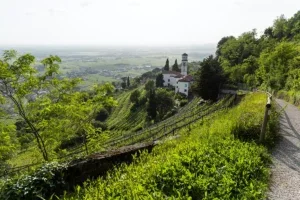With the 2024 Grandi Vini della Contea per la Pace auction in full swing this weekend, Jim Clarke tells the story of the 18th-century vineyard classification of the “princely county” or “Contea” of Gorizia-Gradisca, and its galvanizing relevance for vignerons on either side of the Italy-Slovenia border today.
Forty years ago, historian and journalist Stefano Cosma was conducting research in the library at Villa Russiz, a property well-known to fans of Italian wine, but also an estate of vast importance to the region’s winemaking history. In 1868 Julius Hector Ritter de Zahony gave the estate to his daughter, Elvine, and her new husband, Count Theodor Karl Leopold Anton de la Tour Voivrè, on the occasion of their wedding. De la Tour was of French descent and imported many of the French grape varieties that would eventually “go native” in Friuli and become as much a part of the local landscape as Ribolla Gialla and Malvazia Istriana. But Cosma discovered something even older: a circular dating to March 17, 1787, issued by the Empress-Queen Maria Theresa of Austria, that classified the wines of almost two hundred local villages according to their quality.
The villages stretched across the princely county, or “Contea,” of Gorizia-Gradisca, named for its two most prominent cities at the time, Gorizia and Gradisca. The Empress’s classification is rigorous, or at least extensive, dividing the villages into nine tiers. “Probably the real reason for the wine classification was purely fiscal,” says Gianni Napolitano, Technical Director at local
This Article was originally published on World of Fine Wine



![Tailgaters: University of Georgia [Video]](https://wineconstantly.com/wp-content/uploads/2023/10/tailgaters-episode-georgia-social-1024x535-1-768x401.png)

